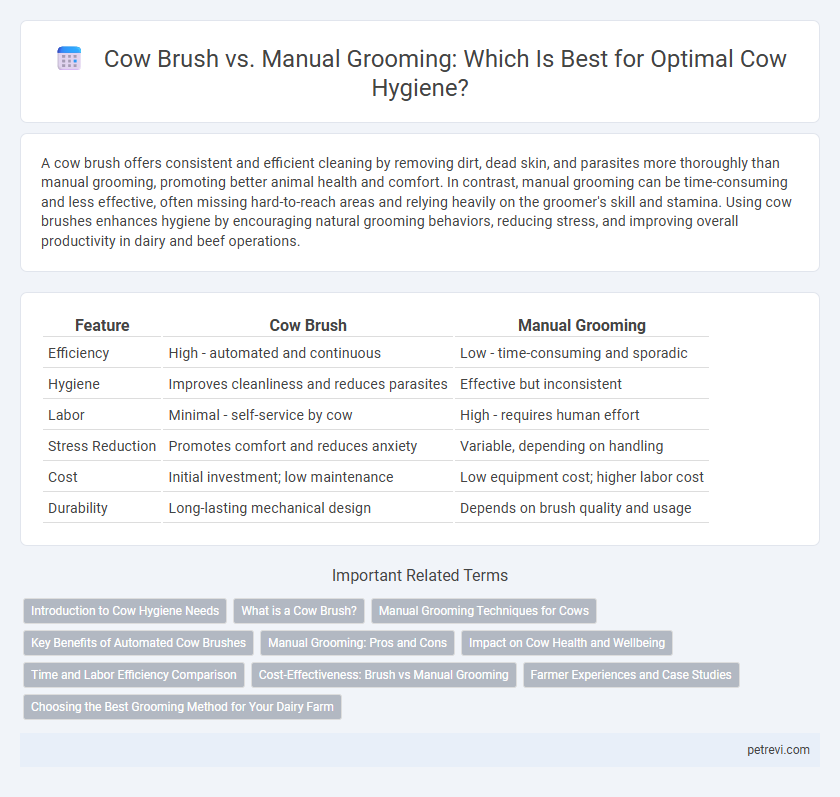A cow brush offers consistent and efficient cleaning by removing dirt, dead skin, and parasites more thoroughly than manual grooming, promoting better animal health and comfort. In contrast, manual grooming can be time-consuming and less effective, often missing hard-to-reach areas and relying heavily on the groomer's skill and stamina. Using cow brushes enhances hygiene by encouraging natural grooming behaviors, reducing stress, and improving overall productivity in dairy and beef operations.
Table of Comparison
| Feature | Cow Brush | Manual Grooming |
|---|---|---|
| Efficiency | High - automated and continuous | Low - time-consuming and sporadic |
| Hygiene | Improves cleanliness and reduces parasites | Effective but inconsistent |
| Labor | Minimal - self-service by cow | High - requires human effort |
| Stress Reduction | Promotes comfort and reduces anxiety | Variable, depending on handling |
| Cost | Initial investment; low maintenance | Low equipment cost; higher labor cost |
| Durability | Long-lasting mechanical design | Depends on brush quality and usage |
Introduction to Cow Hygiene Needs
Cow hygiene is essential for maintaining udder health, preventing infections such as mastitis, and improving overall animal welfare. Automated cow brushes provide consistent, gentle exfoliation that removes dirt, loose hair, and skin debris more effectively than manual grooming methods. Prioritizing regular grooming with cow brushes enhances cleanliness, reduces stress, and supports optimal milk production.
What is a Cow Brush?
A cow brush is an automated or motorized grooming tool designed to enhance cow hygiene by removing dirt, debris, and loose hair from the animal's coat. These brushes improve skin health and increase cow comfort by providing consistent and thorough cleaning compared to manual grooming. Studies show that cows using brushes exhibit reduced stress levels and better overall hygiene, which contributes to higher milk production and improved welfare.
Manual Grooming Techniques for Cows
Manual grooming techniques for cows include brushing with handheld brushes, using curry combs, and scraping tools to remove dirt, loose hair, and parasites. These methods improve blood circulation, promote healthy skin, and reduce stress, contributing to overall cow hygiene and comfort. Regular manual grooming supports better milk production by maintaining cleanliness and preventing infections.
Key Benefits of Automated Cow Brushes
Automated cow brushes significantly enhance cow hygiene by effectively removing dirt, dead skin, and parasites more consistently than manual grooming. These brushes improve animal welfare by providing cows with the opportunity to self-groom, reducing stress and promoting natural behavior. Studies show that automated brushing can lead to increased milk production and overall health due to better skin condition and cleanliness.
Manual Grooming: Pros and Cons
Manual grooming for cow hygiene offers precise control over targeted cleaning and inspection, allowing handlers to address specific areas of dirt or irritation effectively. However, it is time-consuming and labor-intensive, requiring consistent effort to maintain optimal cleanliness compared to automated solutions. Despite these drawbacks, manual grooming facilitates early detection of skin issues and strengthens animal-handler bonds, which can enhance overall health and productivity.
Impact on Cow Health and Wellbeing
Automated cow brushes enhance cow hygiene by reducing skin lesions, promoting blood circulation, and lowering stress levels compared to manual grooming. Studies indicate cows using brushes exhibit improved coat condition and higher activity, leading to better overall health and milk production. Manual grooming, while beneficial, is less consistent and can overlook hard-to-reach areas, potentially compromising cow wellbeing.
Time and Labor Efficiency Comparison
Cow brushes significantly reduce grooming time by providing continuous, automated cleaning that allows cows to self-groom efficiently, minimizing the need for manual labor. Manual grooming demands considerable time investment and physical effort from farm workers, often leading to inconsistent cleanliness and increased labor costs. Implementing cow brushes enhances time and labor efficiency by promoting consistent hygiene with less human intervention.
Cost-Effectiveness: Brush vs Manual Grooming
Cow brushes offer a more cost-effective solution for maintaining cow hygiene by reducing labor time and improving animal comfort compared to manual grooming, which requires consistent human effort and time investment. Automated brushes contribute to better skin health and cleanliness, decreasing veterinary costs associated with skin infections and promoting higher milk yield. While initial brush installation incurs upfront expenses, the long-term savings in labor and health benefits make it a financially advantageous choice for dairy farms.
Farmer Experiences and Case Studies
Farmers report that cow brushes significantly improve hygiene by reducing dirt and parasites more effectively than manual grooming, leading to healthier skin and increased animal comfort. Case studies show that automated brushes decrease grooming time for staff, allowing more attention to other farm duties while enhancing cows' natural grooming behavior and overall welfare. This method also supports higher milk yield due to reduced stress and better cleanliness compared to traditional hand grooming.
Choosing the Best Grooming Method for Your Dairy Farm
Cow brushes provide consistent, efficient grooming by reducing dirt, parasites, and skin irritation, promoting better udder health and milk production on dairy farms. Manual grooming, while labor-intensive and time-consuming, allows for personalized care and close monitoring of cow health during cleaning. Choosing the best method depends on farm size, labor availability, and herd management goals, but integrating automated cow brushes often leads to improved hygiene and overall animal welfare.
Cow Brush vs Manual Grooming for Cow Hygiene Infographic

 petrevi.com
petrevi.com